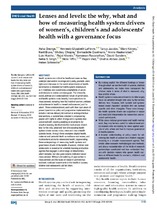| dc.description.abstract | Health systems are critical for health outcomes as they
underpin intervention coverage and quality, promote users’
rights and intervene on the social determinants of health.
Governance is essential for health system endeavours
as it mobilises and coordinates a multiplicity of actors
and interests to realise common goals. The inherently
social, political and contextualised nature of governance,
and health systems more broadly, has implications for
measurement, including how the health of women, children
and adolescents health is viewed and assessed, and for
whom. Three common lenses, each with their own views of
power dynamics in policy and programme implementation,
include a service delivery lens aimed at scaling effective
interventions, a societal lens oriented to empowering
people with rights to effect change and a systems lens
concerned with creating enabling environments for
adaptive learning. We illustrate the implications of each
lens for the why, what and how of measuring health
system drivers across micro, meso and macro health
systems levels, through three examples (digital health,
maternal and perinatal death surveillance and review, and
multisectoral action for adolescent health). Appreciating
these underpinnings of measuring health systems and
governance drivers of the health of women, children and
adolescents is essential for a holistic learning and action
agenda that engages a wider range of stakeholders,
which includes, but also goes beyond, indicator-based
measurement. Without a broadening of approaches to
measurement and the types of research partnerships
involved, continued investments in the health of women,
children and adolescents will fall short. | en_US |

